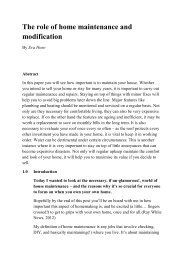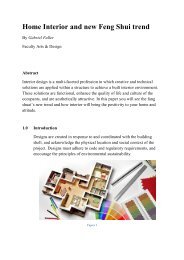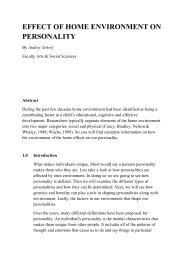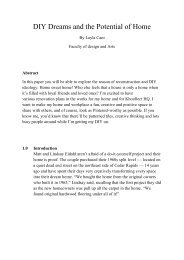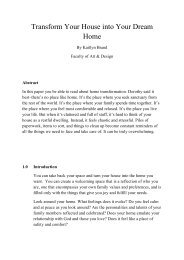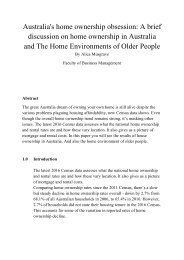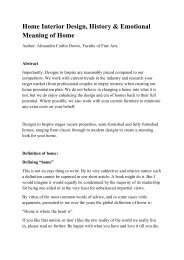Keep Your House in good Shape An Incredibly Handy Home Maintenance Guide
Create successful ePaper yourself
Turn your PDF publications into a flip-book with our unique Google optimized e-Paper software.
<strong>Keep</strong> <strong>Your</strong> <strong>House</strong> <strong>in</strong> Tip-Top <strong>Shape</strong>: <strong>An</strong><br />
<strong>Incredibly</strong> <strong>Handy</strong> <strong>Home</strong> Ma<strong>in</strong>tenance <strong>Guide</strong><br />
By Dakota Prieur<br />
Faculty of design and Arts<br />
Abstract<br />
No matter what place you call home, the very word strikes a chord deep <strong>in</strong>side<br />
each of us. <strong>Home</strong> means sanctuary, the place we can rest, relax, enjoy time with<br />
friends, learn, grow and just be. Our homes say a lot about who we are and what<br />
we th<strong>in</strong>k is important <strong>in</strong> life. In this paper you will see the importance of a home<br />
and you can ma<strong>in</strong>ta<strong>in</strong> it for your better lifestyle.<br />
1.0 Introduction<br />
Our homes say a lot about who we are and what we th<strong>in</strong>k is important <strong>in</strong><br />
life.<br />
"Sacred Space is where you can f<strong>in</strong>d yourself aga<strong>in</strong> and aga<strong>in</strong>." - Joseph<br />
Campbell<br />
You do not have to be wealthy or have a large house to create a space that<br />
constantly rem<strong>in</strong>ds you of your own deepest values and hopes and<br />
<strong>in</strong>spires you to realize them. For example, the house I live <strong>in</strong> now has<br />
been furnished on a shoestr<strong>in</strong>g. My night stands come from a hospital <strong>in</strong><br />
Wyom<strong>in</strong>g and were given to me by a great friend who delivered babies<br />
there. The coffee table <strong>in</strong> my liv<strong>in</strong>g room is an old wooden, hand-whittled<br />
chicken coop that is 75 years old. The most expensive feature <strong>in</strong> my<br />
whole home is an Indian poster I received as a gift. Everyth<strong>in</strong>g else I own<br />
was either picked up while travel<strong>in</strong>g, discovered <strong>in</strong> thrift stores or garage<br />
sales—even back alleys on garbage collection days—and from wonderful
easonably priced stores like Pier One. I mention this to make it clear that<br />
what you need to create a sacred space is NOT money, but what each of<br />
us already has: creativity, <strong>in</strong>tuitive guidance, imag<strong>in</strong>ation and <strong>in</strong>spiration.<br />
1.1 The importance of home<br />
No matter what place you call home, the very word strikes a<br />
chord deep <strong>in</strong>side each of us. <strong>Home</strong> means sanctuary, the place we<br />
can rest, relax, enjoy time with friends, learn, grow … and just be.<br />
Our homes say a lot about who we are and what we th<strong>in</strong>k is<br />
important <strong>in</strong> life.<br />
Figure 1<br />
<strong>Home</strong> is where the heart is but it goes deeper than that. Our<br />
connections to home are basic threads <strong>in</strong> our lives that pop up<br />
automatically <strong>in</strong> casual conversation. We use the word home to<br />
identify where we‘re from (hometown), cheer on players who<br />
represent us <strong>in</strong> sports (home teams), describe a level of comfort (at<br />
home), relate to our national identity (homeland), and at the end of<br />
a vacation, name it as our favorite next dest<strong>in</strong>ation (―There‘s no<br />
place like home.‖).
When we purchase a home, we look for it to provide<br />
comfort, to be a place where we can feel safe and <strong>in</strong>vest our hopes,<br />
dreams and wishes as a foundation for our future. Most of us have<br />
pretty similar goals and <strong>in</strong>tentions <strong>in</strong> life, no matter what size,<br />
shape, color or type of home we choose <strong>in</strong> a given geographic<br />
location. We all want to start a life with a significant other, perhaps<br />
have a family, grow through life‘s stages and eventually retire.<br />
That‘s the American dream. As our lives progress, the daily<br />
demands of family, friends, school, careers and all the unforeseen<br />
events we deal with over time all contribute to the stress <strong>in</strong> the<br />
overall atmosphere <strong>in</strong> the places we call home.<br />
Th<strong>in</strong>k for a moment of your home. If you were to describe it<br />
<strong>in</strong> a word or two, what would it be? Peaceful and calm? Orderly?<br />
Disorganized and chaotic? Messy? Open and welcom<strong>in</strong>g? How<br />
would you compare the way you describe your home to the life you<br />
lead? Our environments are often the exterior reflections of our<br />
<strong>in</strong>terior worlds.<br />
1.2 Trust<strong>in</strong>g our senses: our guides to what we can’t see<br />
Th<strong>in</strong>k back to the last time you went apartment or house<br />
hunt<strong>in</strong>g. (Note how we refer to it as a ―house‖ at first. We don‘t<br />
transition to call<strong>in</strong>g it ―home‖ until we beg<strong>in</strong> to th<strong>in</strong>k of it as ours.)<br />
How did you know whether you liked a space when you first<br />
walked through the door? Did you smile? Sigh? Check to see<br />
where the closest exit is? What was your first tipoff that the space<br />
was a hit or a miss?<br />
Chances are your body told you pretty fast what your<br />
reaction was. We all have a set of <strong>in</strong>tuitive monitors that help us<br />
know quickly whether we want to stay <strong>in</strong> a place or not. They‘re<br />
called our senses. They are an <strong>in</strong>born part of our wir<strong>in</strong>g and with<br />
just a little imag<strong>in</strong>ation, we can call them forth and use them <strong>in</strong><br />
some pretty creative ways.
Figure 2<br />
Draw<strong>in</strong>g on more than 25 years of experience <strong>in</strong> bus<strong>in</strong>ess<br />
and operations management, her creative passion, her education <strong>in</strong><br />
market<strong>in</strong>g and design and her background <strong>in</strong> both psychology and<br />
the mystical arts, Jill took her diverse toolkit <strong>in</strong>to the fast-mov<strong>in</strong>g<br />
world of spiritual self-help publish<strong>in</strong>g, where she has worked with<br />
such authors as Carol<strong>in</strong>e Myss, Marianne Williamson, <strong>An</strong>drew<br />
Harvey, Mathew Fox and Mona Lisa Schulz. Dur<strong>in</strong>g that time she<br />
delved deeply <strong>in</strong>to spiritual studies and practices, travel<strong>in</strong>g<br />
extensively to Asia, Africa, Europe, and North America. (Jill<br />
<strong>An</strong>gelo, 2016)<br />
1.3 <strong>Home</strong>/Property Management<br />
When it comes to gett<strong>in</strong>g the most from your <strong>in</strong>vestment<br />
property, hav<strong>in</strong>g the right property manager <strong>in</strong> Australia makes all<br />
the difference. A <strong>good</strong> property manager will take care of<br />
everyth<strong>in</strong>g, from plac<strong>in</strong>g tenants to handl<strong>in</strong>g major and m<strong>in</strong>or<br />
disputes of all k<strong>in</strong>ds. All you have to do is sit back and enjoy the<br />
benefits as the rental <strong>in</strong>come comes roll<strong>in</strong>g <strong>in</strong>.<br />
Ironfish is now pleased to offer property management<br />
services throughout several major Australian cities. It‘s all part of
the plan to ensure that our valued <strong>in</strong>vestors are gett<strong>in</strong>g the absolute<br />
most for their money.<br />
1.4 Tak<strong>in</strong>g the First Steps<br />
If you‘ve purchased your first <strong>in</strong>vestment property, then the<br />
first th<strong>in</strong>g you need is to get it cleared by the local government as<br />
an official rental unit. This means lodg<strong>in</strong>g the bond and arrang<strong>in</strong>g<br />
for any necessary <strong>in</strong>spections. Our Ironfish Australia property<br />
management team is already familiar with the expectations and the<br />
requirements for rental units <strong>in</strong> their own home towns. They can<br />
help you clear your way through all the hurdles ahead, <strong>in</strong>clud<strong>in</strong>g<br />
lodg<strong>in</strong>g the bond and pass<strong>in</strong>g any required <strong>in</strong>spections.<br />
Figure 3<br />
While this is go<strong>in</strong>g on, the local property manager will<br />
actually visit the unit <strong>in</strong> question to get a feel for it. They may<br />
prepare a condition report to let you know about any issues or<br />
concerns they may have that need to be addressed before the unit<br />
can be rented out. Once the paperwork is done and the property<br />
ready for occupancy, your property manager will take the lead on<br />
f<strong>in</strong>d<strong>in</strong>g and screen<strong>in</strong>g prospective tenants through local channels.<br />
They‘ll be responsible for collect<strong>in</strong>g rents and respond<strong>in</strong>g to<br />
compla<strong>in</strong>ts or mak<strong>in</strong>g repairs.
If any ongo<strong>in</strong>g ma<strong>in</strong>tenance is required, such as garden<strong>in</strong>g or<br />
duct clean<strong>in</strong>g, your Australia property management team will hire<br />
the workers and oversee the job. <strong>An</strong>d <strong>in</strong> the highly unlikely<br />
circumstance that a dispute ever escalates <strong>in</strong>to a lawsuit, your<br />
property manager can represent your <strong>in</strong>terests as the property<br />
owner on your behalf <strong>in</strong> court.<br />
1.5 <strong>Your</strong> Cont<strong>in</strong>ued Success<br />
If you choose to work with Ironfish for your Australia<br />
property needs, then you‘re choos<strong>in</strong>g a real estate management that<br />
specialises <strong>in</strong> the unique demands of Ironfish customers. We have<br />
experience <strong>in</strong> work<strong>in</strong>g with homes and apartments, and with<br />
property owners who may only have one or two units with<strong>in</strong> our<br />
particular area.<br />
Figure 4<br />
We understand that your portfolio isn‘t concentrated <strong>in</strong> one<br />
city but spread out across the entire cont<strong>in</strong>ent, and that this may<br />
very well be your first real estate <strong>in</strong>vestment. You‘ll f<strong>in</strong>d our whole<br />
team to be supportive and eager to help you understand what is<br />
required of you and what it means for your bottom l<strong>in</strong>e.
Ironfish wants to be a part of your success story. We believe<br />
<strong>in</strong> our strategy and <strong>in</strong> the long last<strong>in</strong>g effects of do<strong>in</strong>g th<strong>in</strong>gs the<br />
right way so that you get the most from your <strong>in</strong>vestment. To learn<br />
more about what Ironfish can do for you, visit us at one of our free<br />
sem<strong>in</strong>ars or call to make your appo<strong>in</strong>tment. (ironfish, 2015)<br />
1.6 While Buy<strong>in</strong>g <strong>Home</strong><br />
When buy<strong>in</strong>g a home, most people probably first th<strong>in</strong>k of the<br />
f<strong>in</strong>ancial responsibility. Don‘t let yourself forget, however, about<br />
the time and labor that home ownership also requires. Just like<br />
regular oil changes for your car keep your eng<strong>in</strong>e happy and<br />
healthy, keep<strong>in</strong>g up with regular home ma<strong>in</strong>tenance tasks will keep<br />
you from future headaches and wasted money.<br />
Figure 5<br />
It can be <strong>in</strong>timidat<strong>in</strong>g to th<strong>in</strong>k about these various tasks,<br />
especially if you‘re a new homeowner. It‘s a long list — there‘s no<br />
deny<strong>in</strong>g that. The <strong>good</strong> news is that you can do the majority of it<br />
on your own without much experience. Google is your best friend,<br />
and if you really get stuck, call up your local handyman to help you<br />
out.
In order to maximize your efficiency and actually get all of<br />
these tasks done, you might want to create a home ma<strong>in</strong>tenance<br />
calendar for yourself. Whether onl<strong>in</strong>e or on paper, you can jot<br />
down small, regular tasks for each weekend and not be too<br />
overwhelmed. We‘ve listed tasks that need to be done monthly,<br />
quarterly, and biannually. We‘ve also given you a list of tasks to be<br />
completed seasonally. Not every expert agrees as to which task<br />
needs to be done <strong>in</strong> which season, so this isn‘t a black and white<br />
list, necessarily. Do what works for you and your schedule, and as<br />
long as all these th<strong>in</strong>gs get accomplished, your home will be happy<br />
for years and years to come.(Jeremy <strong>An</strong>derberg, 2013)<br />
2.0 Increas<strong>in</strong>g <strong>in</strong>cidence of malignant mesothelioma dur<strong>in</strong>g home<br />
renovation<br />
Malignant mesothelioma (MM) of the pleura or peritoneum is a<br />
universally fatal disease predom<strong>in</strong>antly caused by exposure to asbestos.<br />
In Australia, the <strong>in</strong>cidence of MM has <strong>in</strong>creased steadily s<strong>in</strong>ce the early<br />
1960s, <strong>in</strong>itially affect<strong>in</strong>g workers m<strong>in</strong><strong>in</strong>g and mill<strong>in</strong>g raw asbestos and<br />
manufactur<strong>in</strong>g asbestos products (the first wave), and then workers who<br />
used asbestos products <strong>in</strong> <strong>in</strong>dustry (the second wave). Over the past 20<br />
years, there has been <strong>in</strong>creas<strong>in</strong>g concern about a third wave people<br />
diagnosed with MM after short-term and/or lowlevel exposure to asbestos<br />
<strong>in</strong> the home or workplace.<br />
Figure 6
<strong>Home</strong> ma<strong>in</strong>tenance and renovation <strong>in</strong>volv<strong>in</strong>g asbestos-conta<strong>in</strong><strong>in</strong>g<br />
build<strong>in</strong>g products is one of the activities most frequently associated with<br />
this third wave. It is a source of ongo<strong>in</strong>g concern, given the widespread<br />
distribution of asbestos-conta<strong>in</strong><strong>in</strong>g products <strong>in</strong> homes and other build<strong>in</strong>gs<br />
<strong>in</strong> Australian cities and towns. Two forms of asbestos serpent<strong>in</strong>e<br />
(chrysotile or white asbestos) and amphibole (crocidolite or blue asbestos,<br />
and amosite or brown asbestos) have been m<strong>in</strong>ed <strong>in</strong> and imported <strong>in</strong>to<br />
Australia. Chrysotile was the ma<strong>in</strong> form of asbestos m<strong>in</strong>ed <strong>in</strong> Australia<br />
until crocidolite was m<strong>in</strong>ed at Wittenoom <strong>in</strong> the north of Western<br />
Australia, beg<strong>in</strong>n<strong>in</strong>g <strong>in</strong> 1943 and cont<strong>in</strong>u<strong>in</strong>g until 1966. More than 60%<br />
of the crocidolite produced was used <strong>in</strong> the manufactur<strong>in</strong>g of asbestos<br />
cement products. For many years, Australia also imported both raw<br />
asbestos and manufactured asbestos <strong>good</strong>s. By 1954, Australia was<br />
ranked fourth among Western countries (after the United States, the<br />
United K<strong>in</strong>gdom and France) for gross consumption of asbestos cement<br />
products. However, on a per capita basis, Australia was top of the list.2<br />
After World War II, asbestos cement products were commonly used as a<br />
build<strong>in</strong>g material <strong>in</strong> Australia.<br />
Figure 7<br />
Asbestos cement products used <strong>in</strong> build<strong>in</strong>g <strong>in</strong>clude fibro sheet<strong>in</strong>g; water,<br />
dra<strong>in</strong>age and flue pipes; roof<strong>in</strong>g sh<strong>in</strong>gles and gutter<strong>in</strong>g. Until the 1960s,<br />
25% of all new homes were clad <strong>in</strong> asbestos cement. The use of asbestos
was slowly phased out <strong>in</strong> the 1970s and 1980s, but it is still found <strong>in</strong><br />
structures built <strong>in</strong> the late 1980s. A total ban on the use of any type of<br />
asbestos was not <strong>in</strong>troduced <strong>in</strong> Australia until 2003. Direct occupational<br />
exposure to raw asbestos or asbestos products rema<strong>in</strong>s the predom<strong>in</strong>ant<br />
cause of MM, and the number of cases is not expected to peak until<br />
2020.3 However, with the ban on m<strong>in</strong><strong>in</strong>g and asbestos use, the number of<br />
occupational cases will decrease over the next 20–30 years.3 On the other<br />
hand, MM cases as a result of non-occupational exposure to asbestos are<br />
<strong>in</strong>creas<strong>in</strong>g, and there is little understand<strong>in</strong>g of when, and at what level,<br />
this third wave will peak. We describe here the chang<strong>in</strong>g trend <strong>in</strong><br />
<strong>in</strong>cidence of MM <strong>in</strong> WA, and the <strong>in</strong>creas<strong>in</strong>g numbers and relative<br />
proportions of people with MM whose exposure is unrelated to their<br />
occupation, especially those exposed to asbestos dur<strong>in</strong>g home<br />
ma<strong>in</strong>tenance and renovation.(Nola J Olsen,Peter J Frankl<strong>in</strong>, 2011)<br />
3.0 <strong>Home</strong> ma<strong>in</strong>tenance and Education<br />
Variations <strong>in</strong> the home environments of poor and middle-<strong>in</strong>come children<br />
affect their literacy development, which leads to substantial differences <strong>in</strong><br />
read<strong>in</strong>g ability and behavior. Schools can mediate <strong>in</strong>fluences from home<br />
through the conditions that they foster and the <strong>in</strong>structional policies and<br />
procedures they promote. The result of schools' efforts may either<br />
ameliorate or magnify the <strong>in</strong>equities <strong>in</strong> read<strong>in</strong>g development related to<br />
family economic conditions.<br />
Figure 8
This study tests these contentions <strong>in</strong> middle-grade schools by us<strong>in</strong>g a<br />
nationally representative sample of poor and middle-class eighth graders<br />
from the National Education Longitud<strong>in</strong>al Study of 1988 (NELS:88).<br />
<strong>Home</strong> and school effects on our measure of literacy development--a<br />
standardized test of read<strong>in</strong>g comprehension--are explored with multilevel<br />
methods (hierarchical l<strong>in</strong>ear model<strong>in</strong>g). While homes exert an important<br />
<strong>in</strong>fluence on this outcome, f<strong>in</strong>d<strong>in</strong>gs focus<strong>in</strong>g on schools and classrooms<br />
are emphasized. The study also highlights school conditions and policies<br />
that foster social equity <strong>in</strong> the literacy development of young adolescents.<br />
Implications of current school reform efforts are discussed.(Lee &<br />
Cron<strong>in</strong>ger, 1994)<br />
4.0 Impact of home ma<strong>in</strong>tenance and modification services on health<br />
4.1 Def<strong>in</strong><strong>in</strong>g the Conceptualis<strong>in</strong>g HMM Into<br />
The purpose of this chapter is to provide a conceptualisation of<br />
HMM services andprograms that both <strong>in</strong>cludes and transcends<br />
particular policy and service fields. A characteristic of HMM<br />
services <strong>in</strong> many countries, <strong>in</strong>clud<strong>in</strong>g Australia, is that they are<br />
located at the <strong>in</strong>tersection of the health, community care and<br />
hous<strong>in</strong>g policy fields. In the USA, they have been described as a<br />
‗complex patchwork‘ where various types of services have been<br />
developed and delivered through different service systems, each<br />
with their own particular goals, approaches and <strong>in</strong>terventions<br />
(Pynoos, 2001). In order to develop a comprehensive<br />
understand<strong>in</strong>g of HMM policy and service systems, it is<br />
therefore necessary to beg<strong>in</strong> by exam<strong>in</strong><strong>in</strong>g the ways that HMM<br />
have been conceptualised <strong>in</strong> the policy and professional literatures<br />
<strong>in</strong> each of the health, community care and hous<strong>in</strong>g contexts. While<br />
these are overlapp<strong>in</strong>g contexts with a number of commonalities,<br />
each provides a dist<strong>in</strong>ctive perspective on HMM <strong>in</strong> terms of<br />
the goals and <strong>in</strong>tervention repertoires of HMM, and l<strong>in</strong>ks to wider<br />
policy issues. In this chapter, each of these three approaches to<br />
HMM is analysed, draw<strong>in</strong>g primarily on the <strong>in</strong>ternational policy<br />
and professional literature. In the f<strong>in</strong>al section of the chapter, a<br />
conceptualisation of HMM is proposed that <strong>in</strong>tegrates the ma<strong>in</strong><br />
themes from the health, community care and hous<strong>in</strong>g literature. It
is argued that this ‗jo<strong>in</strong>ed-up‘ def<strong>in</strong>ition provides a foundation for<br />
an <strong>in</strong>clusive approach to the analysis and development of HMM<br />
services <strong>in</strong> the Australian context that recognises the contribution<br />
of HMM services and programs to health, community care and<br />
hous<strong>in</strong>g objectives.<br />
4.2 Health Perspective<br />
The terms ‗home modifications‘ and ‗home adaptations‘ have been<br />
used widely <strong>in</strong> health care contexts to refer to ‗any permanent<br />
alteration to a build<strong>in</strong>g carried out with the <strong>in</strong>tention of mak<strong>in</strong>g the<br />
build<strong>in</strong>g more suitable for a disabled person‘ (Heywood, 2004a,<br />
p.134). Somewhat more broadly, these services have been def<strong>in</strong>ed<br />
as ‗changes made <strong>in</strong> a home environment <strong>in</strong> order to accommodate<br />
a particular set of human abilities‘ (Bridge, 2005). From this<br />
perspective, home modifications are viewed as corrective for<br />
problems specific to an <strong>in</strong>dividual, with<strong>in</strong> a broadly medical<br />
approach (Wylde, 1998).<br />
Figure 9<br />
Services are provided as part of discharge plann<strong>in</strong>g follow<strong>in</strong>g<br />
hospitalisation (Auriemma et al., 1999) or with<strong>in</strong> community<br />
health or health-funded <strong>in</strong>home services.<br />
In the context of health care systems, home modifications are<br />
generally recommended by professionals to ensure that a person<br />
with a particular impairment or health condition is safe and
<strong>in</strong>dependent <strong>in</strong> their home (Auriemma et al., 1999), and to reduce<br />
the likelihood of admission to a hospital or care facility (Auriemma<br />
et al., 1999; Gitl<strong>in</strong>, Miller, and Boyce, 1999). The health condition<br />
is generally seen as hav<strong>in</strong>g a predictable pathology, which allows<br />
care to be rout<strong>in</strong>ely managed and provided.<br />
Often recommendations are made with reference to a specific<br />
health problem and less consideration is given to other difficulties<br />
or impairments the person may have (T<strong>in</strong>ker et al., 2004). <strong>Home</strong><br />
modifications may be part of a suite of <strong>in</strong>terventions, <strong>in</strong>clud<strong>in</strong>g<br />
medication and remedial exercise, which focus on remediation or<br />
correction of the health condition. However, home modifications,<br />
along with assistive devices and other <strong>in</strong>terventions, are also used<br />
where function is permanently impaired. With the focus be<strong>in</strong>g on<br />
the health condition of the person and the result<strong>in</strong>g consequences,<br />
<strong>in</strong>terventions that remediate the condition or address the result<strong>in</strong>g<br />
dysfunction directly are prioritised.(Jones, De Jonge, & Phillips,<br />
2008)<br />
5.0 Monthly home ma<strong>in</strong>tenance Check List<br />
5.1 Inspect, and possibly change out HVAC filters<br />
Many experts will say to change the filters monthly, but that‘s not<br />
always necessary. For smaller families without pets or allergies,<br />
you‘ll likely be okay chang<strong>in</strong>g the filters every 2-3 months. If the<br />
filter is dirty, change it out, otherwise <strong>in</strong>spect it aga<strong>in</strong> next month.<br />
I‘ve also been told by handymen to go with cheaper filters and<br />
replace them more often versus go<strong>in</strong>g with the expensive filters.<br />
(You can also get it out of your m<strong>in</strong>d by us<strong>in</strong>g a delivery service<br />
like Cleaner Filters.)<br />
5.2 Clean kitchen s<strong>in</strong>k disposal<br />
There are a bunch of ways to do this, but the handiest and best allaround<br />
solution seems to be v<strong>in</strong>egar ice cubes. Put some v<strong>in</strong>egar <strong>in</strong><br />
an ice tray and let it freeze, then run the ice cubes through the
disposal. It freshens it, but as a bonus, ice sharpens the blades.<br />
You‘re welcome.<br />
5.3 Clean range hood filters<br />
If you‘ve never thought of do<strong>in</strong>g this, you‘re <strong>in</strong> for a real ―treat‖<br />
when you get that filter off the hood to clean it for the first time.<br />
The Family <strong>Handy</strong>man suggests simply us<strong>in</strong>g a degreaser from an<br />
auto parts store mixed with hot water. Let the filter sit for a few<br />
m<strong>in</strong>utes, r<strong>in</strong>se it off, and you‘re <strong>good</strong> to go.<br />
5.4 Inspect your fire ext<strong>in</strong>guisher(s)<br />
We‘ll assume you have and know how to use an ext<strong>in</strong>guisher. This<br />
<strong>in</strong>spection doesn‘t require much: ensure it has easy access (not<br />
be<strong>in</strong>g blocked by a garbage can or anyth<strong>in</strong>g else), that the gauge<br />
shows adequate pressure, and that it has no visible signs of wear<br />
and tear.(Seixas, 1994)<br />
6.0 Quarterly<br />
6.1 Test smoke/carbon dioxide detectors. <strong>An</strong>other simple task; your<br />
detectors should have a ―test‖ button. If the alarm sounds, you‘re<br />
<strong>good</strong> to go. If not, replace batteries immediately and test aga<strong>in</strong>. If it<br />
still doesn‘t sound, it‘s possible there‘s simply corrosion on the<br />
battery term<strong>in</strong>al, and it won‘t detect new batteries. Clean it and try<br />
aga<strong>in</strong>. If it still doesn‘t work, you‘ll likely need a new detector.<br />
6.2 Test garage door auto-reverse feature. In 1993, federal law<br />
required all garage doors to have this feature after multiple child<br />
deaths. Test every month by plac<strong>in</strong>g a 2×4 on the ground where the<br />
door would close. It should reverse after a second or so when the<br />
door hits the wood. Also test the photo-electric sensors if you have<br />
them by plac<strong>in</strong>g someth<strong>in</strong>g <strong>in</strong> front of them (not your body). If the<br />
door doesn‘t immediately go back up, you have a problem.<br />
6.3 Run water and flush toilets <strong>in</strong> unused spaces. This mostly<br />
applies to guest bathrooms, or any other s<strong>in</strong>ks/water sources you<br />
don‘t use on a regular basis. The idea is to prevent grime or any<br />
other k<strong>in</strong>d of build up. Regularly runn<strong>in</strong>g a little bit of water<br />
through will prevent this.<br />
6.4 Check water softener, add salt if needed. You shouldn‘t need to<br />
add salt every month, but better to check anyway, as it only takes<br />
about 5 seconds.(Hurtado, 1994)
7.0 Biannually<br />
7.1 Test your water heater’s pressure relief valve. This will prevent<br />
m<strong>in</strong>eral and corrosion buildup, which safeguards aga<strong>in</strong>st leaks. It<br />
will also help your heater run more efficiently.<br />
7.2 Give your house a deep clean. Take one Saturday every six<br />
months with your whole family, and give the whole house a proper<br />
deep clean. Appliances, w<strong>in</strong>dows, dust<strong>in</strong>g every nook and cranny<br />
(<strong>in</strong>clud<strong>in</strong>g the basement), etc. <strong>Keep</strong><strong>in</strong>g th<strong>in</strong>gs clean and not lett<strong>in</strong>g<br />
dirt/grime/dust build up over years and years will help keep your<br />
home <strong>in</strong> tip-top shape.<br />
7.3 Replace batteries <strong>in</strong> smoke/carbon dioxide detectors. I‘d never<br />
heard this before, actually. I just assumed you changed it out when<br />
it started giv<strong>in</strong>g you the low battery beep<strong>in</strong>g noise. This tip was <strong>in</strong><br />
everyth<strong>in</strong>g we researched, however. With someth<strong>in</strong>g as important<br />
as this, you can‘t be too careful, and batteries won‘t break your<br />
bank. Change ‗em out every six months.<br />
7.4 Vacuum your refrigerator coils. I actually learned this tip from a<br />
refrigerator repairman, and our research confirmed it. The fridge<br />
can use up to 15 percent of your home‘s total power, so you want it<br />
runn<strong>in</strong>g as efficiently as possible. Over time, the coils get dirty and<br />
your fridge requires more juice. You can save up to $100 a year by<br />
do<strong>in</strong>g this, and it‘s not at all a difficult task.(Coburn, 2016)<br />
8.0 Conclusion<br />
As delivery of health care <strong>in</strong> the home becomes more common, more<br />
coherent strategies and effective policies are needed to support the<br />
workforce of <strong>in</strong>dividuals who provide this care. Develop<strong>in</strong>g these will<br />
require a comprehensive understand<strong>in</strong>g of the number and attributes of<br />
<strong>in</strong>dividuals engaged <strong>in</strong> health care <strong>in</strong> the home as well as the context <strong>in</strong><br />
which care is delivered. Data and data analysis are lack<strong>in</strong>g to accomplish<br />
this objective.
National data regard<strong>in</strong>g the numbers of <strong>in</strong>dividuals engaged <strong>in</strong> health care<br />
delivery <strong>in</strong> the home—that is, both formal and <strong>in</strong>formal caregivers—are<br />
sparse, and the estimates that do exist vary widely. Although the Bureau<br />
of Labor Statistics publishes estimates of the number of workers<br />
employed <strong>in</strong> the home sett<strong>in</strong>g for some health care classifications, they do<br />
not <strong>in</strong>clude all relevant health care workers.<br />
Figure 10<br />
<br />
For example, data on workers employed directly by care recipients and<br />
their families are notably absent. Likewise, national estimates of the<br />
number of <strong>in</strong>formal caregivers are obta<strong>in</strong>ed from surveys that use<br />
different methodological approaches and return significantly different<br />
results.(Bondclean<strong>in</strong>g<strong>in</strong>perth, 2016)<br />
Although numerous national surveys have been designed to answer a<br />
broad range of questions regard<strong>in</strong>g health care delivery <strong>in</strong> the home, with<br />
rare exceptions such surveys reflect the relatively limited perspective of<br />
the sponsor<strong>in</strong>g agency. For example,<br />
The Medicare Current Beneficiary Survey (adm<strong>in</strong>istered by the Centers<br />
for Medicare & Medicaid Services) and the Health and Retirement<br />
Survey (adm<strong>in</strong>istered by the National Institute on Ag<strong>in</strong>g) are primarily<br />
geared toward understand<strong>in</strong>g the health, health services use, and/or<br />
economic well-be<strong>in</strong>g of older adults and provide no <strong>in</strong>formation<br />
regard<strong>in</strong>g work<strong>in</strong>g-age adults or children or <strong>in</strong>formation about home or<br />
neighborhood environments.
The Behavioral Risk Factors Surveillance Survey (adm<strong>in</strong>istered by the<br />
Centers for Disease Control and Prevention, CDC), the National Health<br />
Interview Survey (adm<strong>in</strong>istered by the CDC), and the National Children‘s<br />
Study (adm<strong>in</strong>istered by the U.S. Department of Health and Human<br />
Services and the U.S. Environmental Protection Agency) all collect<br />
<strong>in</strong>formation on health characteristics, with limited or no <strong>in</strong>formation<br />
about the hous<strong>in</strong>g context.<br />
<br />
The American Hous<strong>in</strong>g Survey (adm<strong>in</strong>istered by the U.S. Department of<br />
Hous<strong>in</strong>g and Urban Development) collects detailed <strong>in</strong>formation regard<strong>in</strong>g<br />
hous<strong>in</strong>g, but it does not <strong>in</strong>clude questions regard<strong>in</strong>g the health status of<br />
residents and does not collect adequate <strong>in</strong>formation about home<br />
modifications and features on an ongo<strong>in</strong>g basis.(Health Care Comes<br />
<strong>Home</strong>, 2011)
9.0 References<br />
Coburn, C. E. (2016). What‘s Policy Got to Do with It? How the Structure-<br />
Agency Debate Can Illum<strong>in</strong>ate Policy Implementation. American Journal<br />
of Education, 122(3), 465–475. https://doi.org/10.1086/685847<br />
Health Care Comes <strong>Home</strong>. (2011). Wash<strong>in</strong>gton, D.C.: National Academies<br />
Press. https://doi.org/10.17226/13149<br />
Hurtado, S. (1994). Graduate School Racial Climates and Academic Self-<br />
Concept among M<strong>in</strong>ority Graduate Students <strong>in</strong> the 1970s. American<br />
Journal of Education, 102(3), 330–351. https://doi.org/10.1086/444072<br />
ironfish. (2015). Property Management Australia. Retrieved May 26, 2018,<br />
from http://www.ironfish.com.au/property-management-australia/<br />
Jeremy <strong>An</strong>derberg. (2013). A <strong>Home</strong> Ma<strong>in</strong>tenance Checklist: <strong>An</strong> <strong>Incredibly</strong><br />
<strong>Handy</strong> Tool to <strong>Keep</strong> <strong>Your</strong> <strong>House</strong> <strong>in</strong> Tip-Top <strong>Shape</strong> | The Art of Manl<strong>in</strong>ess.<br />
Retrieved May 26, 2018, from<br />
https://www.artofmanl<strong>in</strong>ess.com/articles/keep-your-house-<strong>in</strong>-tip-top-shapean-<strong>in</strong>credibly-handy-home-ma<strong>in</strong>tenance-checklist/<br />
Bondclean<strong>in</strong>g<strong>in</strong>perth. (2016). Top 5 Tips to Make <strong>Your</strong> <strong>House</strong> or Room Smell<br />
Nice - Bond Clean<strong>in</strong>g Perth. Retrieved May 26, 2018, from<br />
https://www.bondclean<strong>in</strong>g<strong>in</strong>perth.com.au/top-5-tips-make-house-roomsmell-nice/<br />
Jill <strong>An</strong>gelo. (2016). The Importance of <strong>Home</strong> - Spirituality & Health.<br />
Retrieved May 26, 2018, from<br />
https://spiritualityhealth.com/articles/2016/02/15/importance-home<br />
Jones, A., De Jonge, D., & Phillips, R. (2008). The impact of home ma<strong>in</strong>tenance<br />
and modification services on health, community care and hous<strong>in</strong>g outcomes
<strong>in</strong> later life. Retrieved from<br />
https://www.ahuri.edu.au/__data/assets/pdf_file/0022/2893/AHURI_Positio<br />
n<strong>in</strong>g_Paper_No103-The-impact-of-home-ma<strong>in</strong>tenance-and-modificationservices-on-health.pdf<br />
Lee, V. E., & Cron<strong>in</strong>ger, R. G. (1994). The Relative Importance of <strong>Home</strong> and<br />
School <strong>in</strong> the Development of Literacy Skills for Middle-Grade Students.<br />
American Journal of Education, 102(3), 286–329.<br />
https://doi.org/10.1086/444071<br />
Nola J Olsen,Peter J Frankl<strong>in</strong>, A. R. (2011). Increas<strong>in</strong>g <strong>in</strong>cidence of malignant<br />
mesothelioma after exposure to asbestos dur<strong>in</strong>g home ma<strong>in</strong>tenance and<br />
renova. Research, 271(5). https://doi.org/10.5694/mja11.10125<br />
Seixas, P. (1994). Confront<strong>in</strong>g the Moral Frames of Popular Film: Young<br />
People Respond to Historical Revisionism. American Journal of Education,<br />
102(3), 261–285. https://doi.org/10.1086/444070





